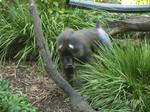Lesson 9 - Ungulates - Hoofed Mammals
Lesson 10 - Primates
What are Vertebrates?

Vertebrates are animals that are relatively complex, with highly developed anatomical and physiological features and complex behaviours. The same might be said for insects and some other animals; but vertebrates are different because they have a "notochord" and nerve chord.
As a rule, chordates are active animals. Their notochord is an exceptionally important characteristic of chordates. It is like a stiffened rod that does not compress. This allows the body muscles to act against the notochord and thus allows the animal to move.
Fish were First
Fishes were the first vertebrates, appearing more that 500 million years ago. They belong to the Subphylum Vertebrate, along with amphibians, mammals, reptiles and birds. They probably evolved from an invertebrate chordate not much different from the tadpole larvae of sea squirts that still inhabit oceans (their larvae are free-swimming and exhibits chordate characteristics: it has a notochord, a dorsal nerve cord, pharyngeal slits, and a post-anal tail). Fish have evolved and developed to now cover a huge range of habitats in the ocean and freshwater ecosystems. Fishes are the most abundant vertebrates in terms of species and individuals. Fifty eight percent of fish are marine.
All fishes are water animals in all stages of their life cycle. They breath with gills (all the other vertebrates have lungs with only a few exceptions in Amphibians). Fishes have a two-chambered heart and are poikilothermal (i.e. – they lack the ability to control constant body temperature, therefore it varies with the environment).
Approximately 20,000-22,000 living species of fishes are currently recognised.
Primates are the Most Advanced
Primates are the most complex group of vertebrates. They include prosimians, monkeys, apes and humans.

Primates started as small arboreal (tree dwelling) animals. These are considered to be the ancestors of all; modern primates; and most primates remained in trees. It is thought that this kept them from danger on the ground. Trees offer protection from predators; and also trees provide a reliable source of food (vegetation, insects, etc). Primates that are ground dwelling now are big sized species or man.
In order to stop them from falling, arboreal primates evolved hands, rather than claws as in other arboreal animals, that can grasp branches firmly. This adaptation had a secondary value, allowing primates the ability to hold and manipulate objects more precisely than other animals.
With more usable hands, primates were better able to jump from branch to branch. To jump more effectively, primates would then need better eyesight; a better sense of touch; and greater intelligence to make faster decisions as they moved through the trees.
How You Study
- When you enroll, we send you an email that explains it all.
- You are given a short orientation video to watch, where our principal introduces you to how the course works, and how you can access all sorts of support services
- You are either given access to your course online, or sent a CD or course materials through the mail (or by courier).
- You work through lessons one by one. Each lesson has at least four parts:
- An aim -which tells you what you should be achieving in the lesson
- Reading -notes written and regularly revised by our academic staff
- Set Task(s) -These are practicals, research or other experiential learning tasks that strengthen and add to what you have been reading
- Assignment -By answering questions, submitting them to a tutor, then getting feedback from the tutor, you confirm that you are on the right track, but more than that, you are guided to consider what you have been studying in different ways, broadening your perspective and reinforcing what you are learning about
- Other - Your work in a course rarely stops at just the above four parts. Different courses and different students will need further learning experiences. Your set task or assignment may lead to other things, interacting with tutors or people in industry, reviewing additional reference materials or something else. We treat every student as an individual and supplement their learning needs as the occasion requires.
- You are given access to and encouraged to use a range of supplementary services including an online student room, including online library; student bookshop, newsletters, social media etc.
- You are provided with a "student manual" which you can refer to if and when needed. It provides a quick solution to most problems that might occur (some people never need to use this; but if you are studying late at night & have a problem, the manual provides a first port of call that can often get you moving again).